brakes Mercury Sable 2002 s User Guide
[x] Cancel search | Manufacturer: MERCURY, Model Year: 2002, Model line: Sable, Model: Mercury Sable 2002Pages: 240, PDF Size: 3.53 MB
Page 151 of 240
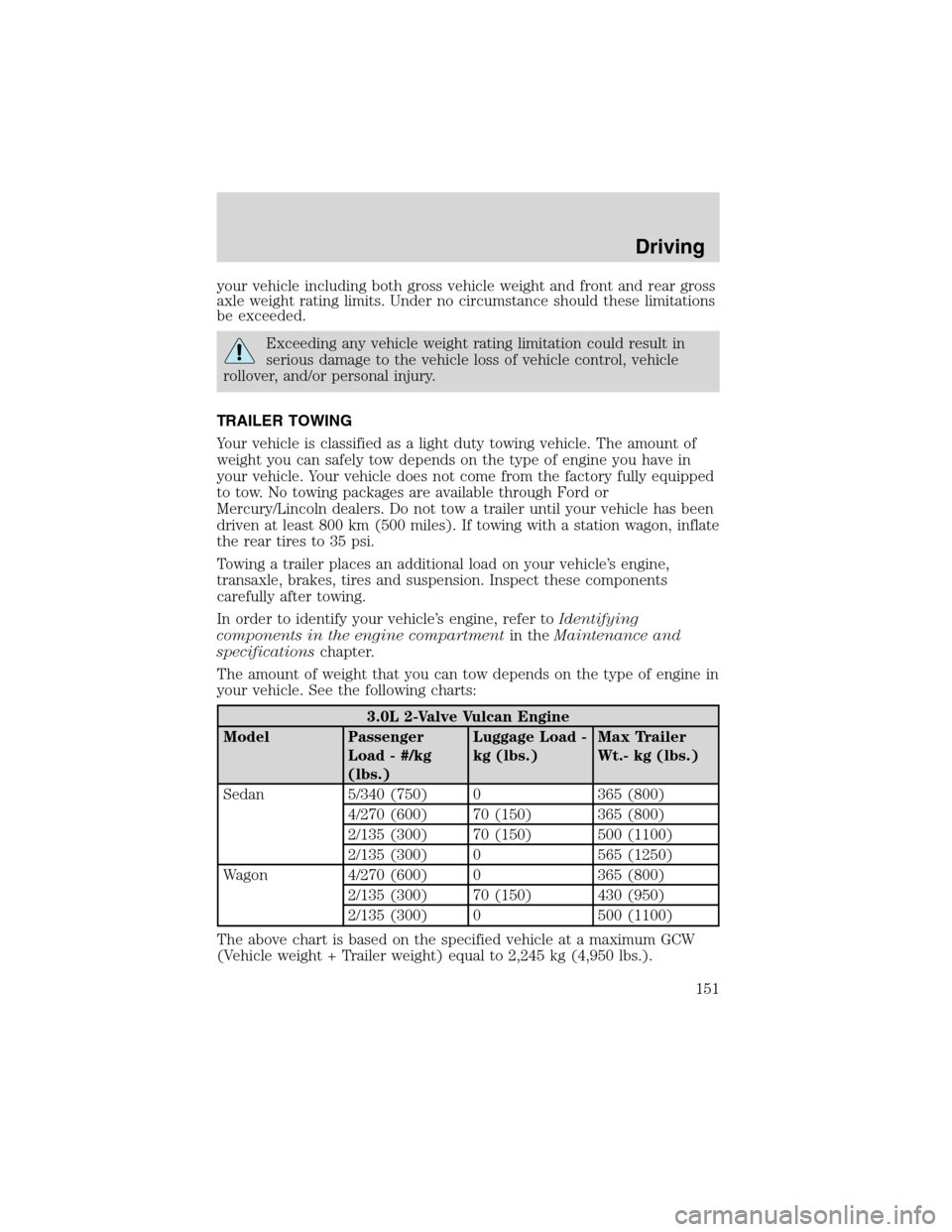
your vehicle including both gross vehicle weight and front and rear gross
axle weight rating limits. Under no circumstance should these limitations
be exceeded.
Exceeding any vehicle weight rating limitation could result in
serious damage to the vehicle loss of vehicle control, vehicle
rollover, and/or personal injury.
TRAILER TOWING
Your vehicle is classified as a light duty towing vehicle. The amount of
weight you can safely tow depends on the type of engine you have in
your vehicle. Your vehicle does not come from the factory fully equipped
to tow. No towing packages are available through Ford or
Mercury/Lincoln dealers. Do not tow a trailer until your vehicle has been
driven at least 800 km (500 miles). If towing with a station wagon, inflate
the rear tires to 35 psi.
Towing a trailer places an additional load on your vehicle’s engine,
transaxle, brakes, tires and suspension. Inspect these components
carefully after towing.
In order to identify your vehicle’s engine, refer toIdentifying
components in the engine compartmentin theMaintenance and
specificationschapter.
The amount of weight that you can tow depends on the type of engine in
your vehicle. See the following charts:
3.0L 2-Valve Vulcan Engine
Model Passenger
Load - #/kg
(lbs.)Luggage Load -
kg (lbs.)Max Trailer
Wt.- kg (lbs.)
Sedan 5/340 (750) 0 365 (800)
4/270 (600) 70 (150) 365 (800)
2/135 (300) 70 (150) 500 (1100)
2/135 (300) 0 565 (1250)
Wagon 4/270 (600) 0 365 (800)
2/135 (300) 70 (150) 430 (950)
2/135 (300) 0 500 (1100)
The above chart is based on the specified vehicle at a maximum GCW
(Vehicle weight + Trailer weight) equal to 2,245 kg (4,950 lbs.).
Driving
151
Page 153 of 240
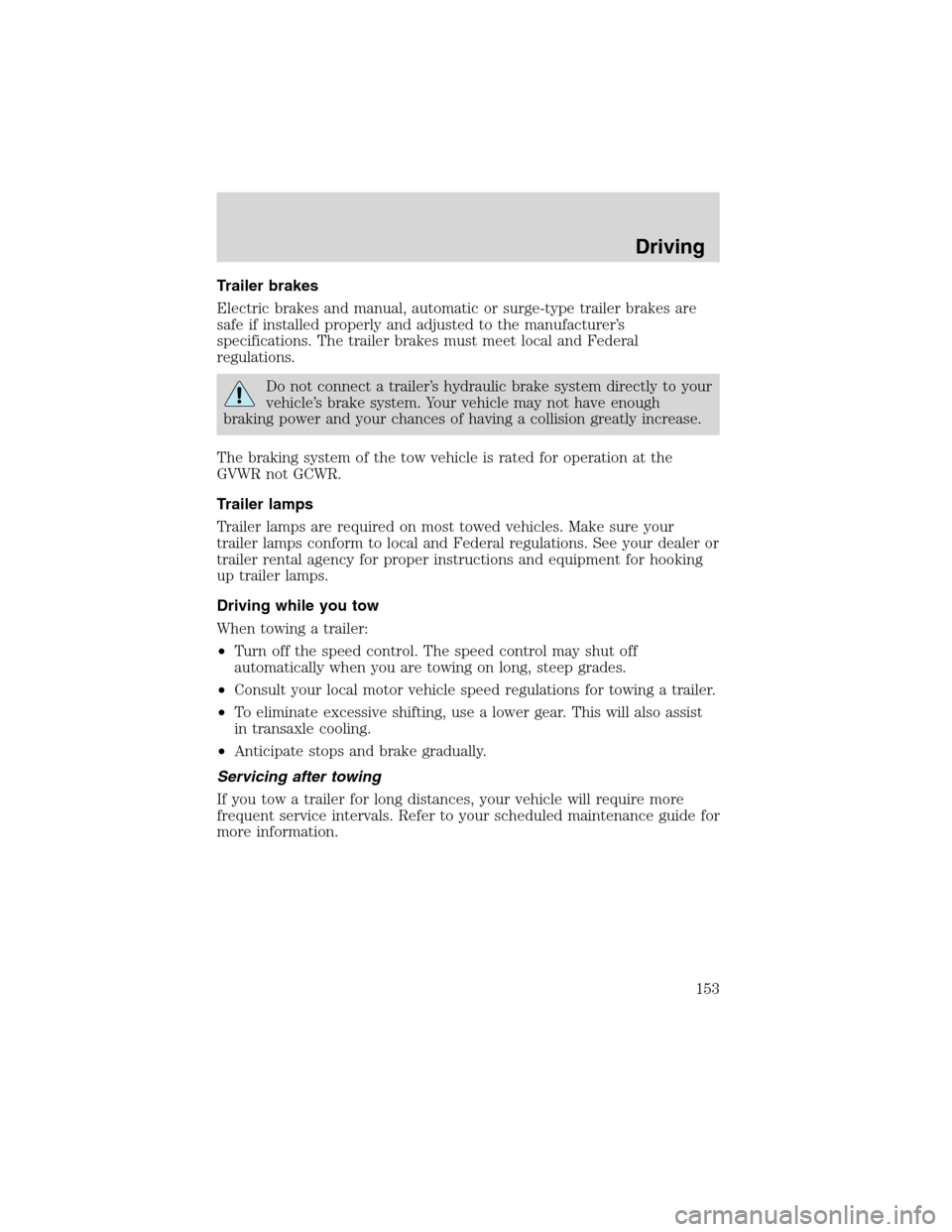
Trailer brakes
Electric brakes and manual, automatic or surge-type trailer brakes are
safe if installed properly and adjusted to the manufacturer’s
specifications. The trailer brakes must meet local and Federal
regulations.
Do not connect a trailer’s hydraulic brake system directly to your
vehicle’s brake system. Your vehicle may not have enough
braking power and your chances of having a collision greatly increase.
The braking system of the tow vehicle is rated for operation at the
GVWR not GCWR.
Trailer lamps
Trailer lamps are required on most towed vehicles. Make sure your
trailer lamps conform to local and Federal regulations. See your dealer or
trailer rental agency for proper instructions and equipment for hooking
up trailer lamps.
Driving while you tow
When towing a trailer:
•Turn off the speed control. The speed control may shut off
automatically when you are towing on long, steep grades.
•Consult your local motor vehicle speed regulations for towing a trailer.
•To eliminate excessive shifting, use a lower gear. This will also assist
in transaxle cooling.
•Anticipate stops and brake gradually.
Servicing after towing
If you tow a trailer for long distances, your vehicle will require more
frequent service intervals. Refer to your scheduled maintenance guide for
more information.
Driving
153
Page 154 of 240
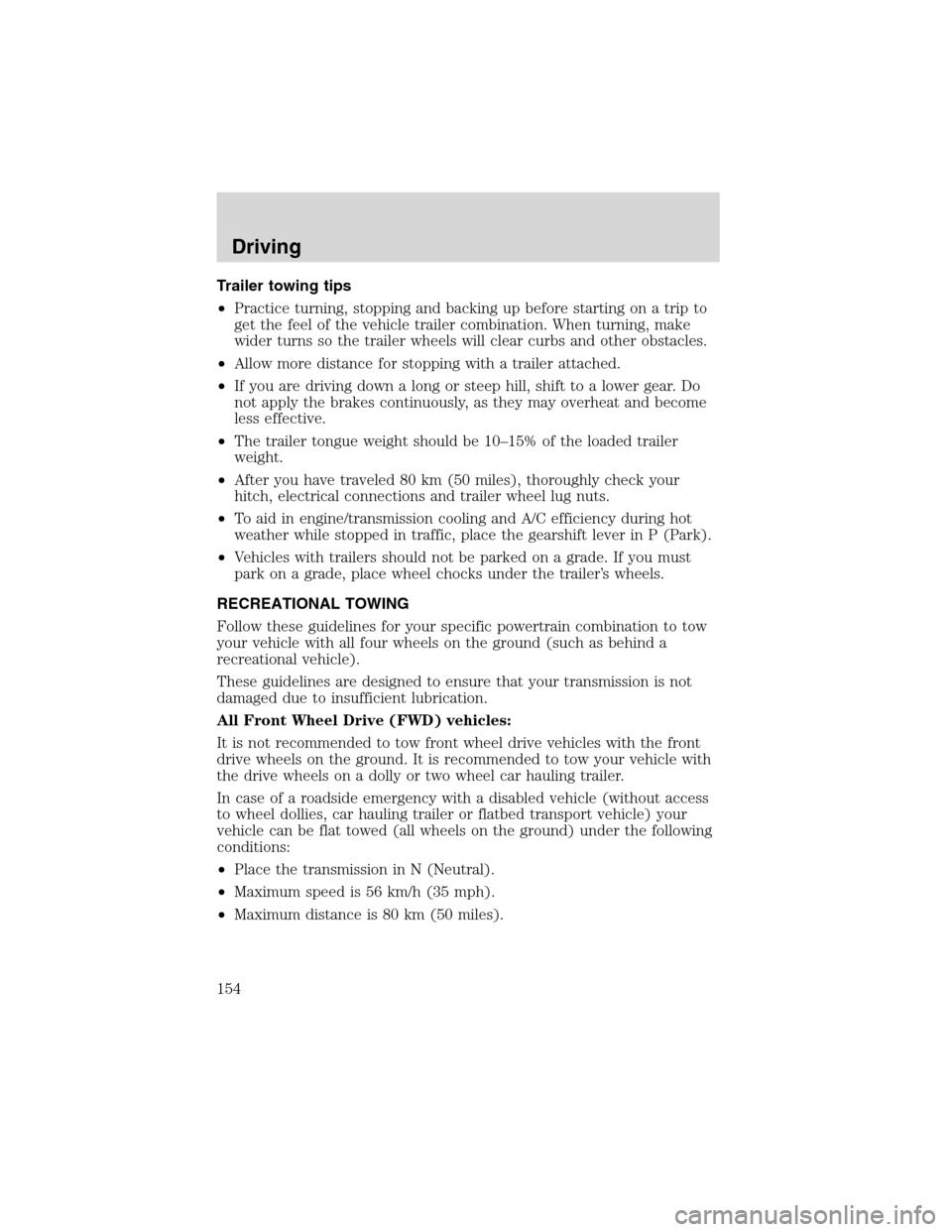
Trailer towing tips
•Practice turning, stopping and backing up before starting on a trip to
get the feel of the vehicle trailer combination. When turning, make
wider turns so the trailer wheels will clear curbs and other obstacles.
•Allow more distance for stopping with a trailer attached.
•If you are driving down a long or steep hill, shift to a lower gear. Do
not apply the brakes continuously, as they may overheat and become
less effective.
•The trailer tongue weight should be 10–15% of the loaded trailer
weight.
•After you have traveled 80 km (50 miles), thoroughly check your
hitch, electrical connections and trailer wheel lug nuts.
•To aid in engine/transmission cooling and A/C efficiency during hot
weather while stopped in traffic, place the gearshift lever in P (Park).
•Vehicles with trailers should not be parked on a grade. If you must
park on a grade, place wheel chocks under the trailer’s wheels.
RECREATIONAL TOWING
Follow these guidelines for your specific powertrain combination to tow
your vehicle with all four wheels on the ground (such as behind a
recreational vehicle).
These guidelines are designed to ensure that your transmission is not
damaged due to insufficient lubrication.
All Front Wheel Drive (FWD) vehicles:
It is not recommended to tow front wheel drive vehicles with the front
drive wheels on the ground. It is recommended to tow your vehicle with
the drive wheels on a dolly or two wheel car hauling trailer.
In case of a roadside emergency with a disabled vehicle (without access
to wheel dollies, car hauling trailer or flatbed transport vehicle) your
vehicle can be flat towed (all wheels on the ground) under the following
conditions:
•Place the transmission in N (Neutral).
•Maximum speed is 56 km/h (35 mph).
•Maximum distance is 80 km (50 miles).
Driving
154
Page 218 of 240
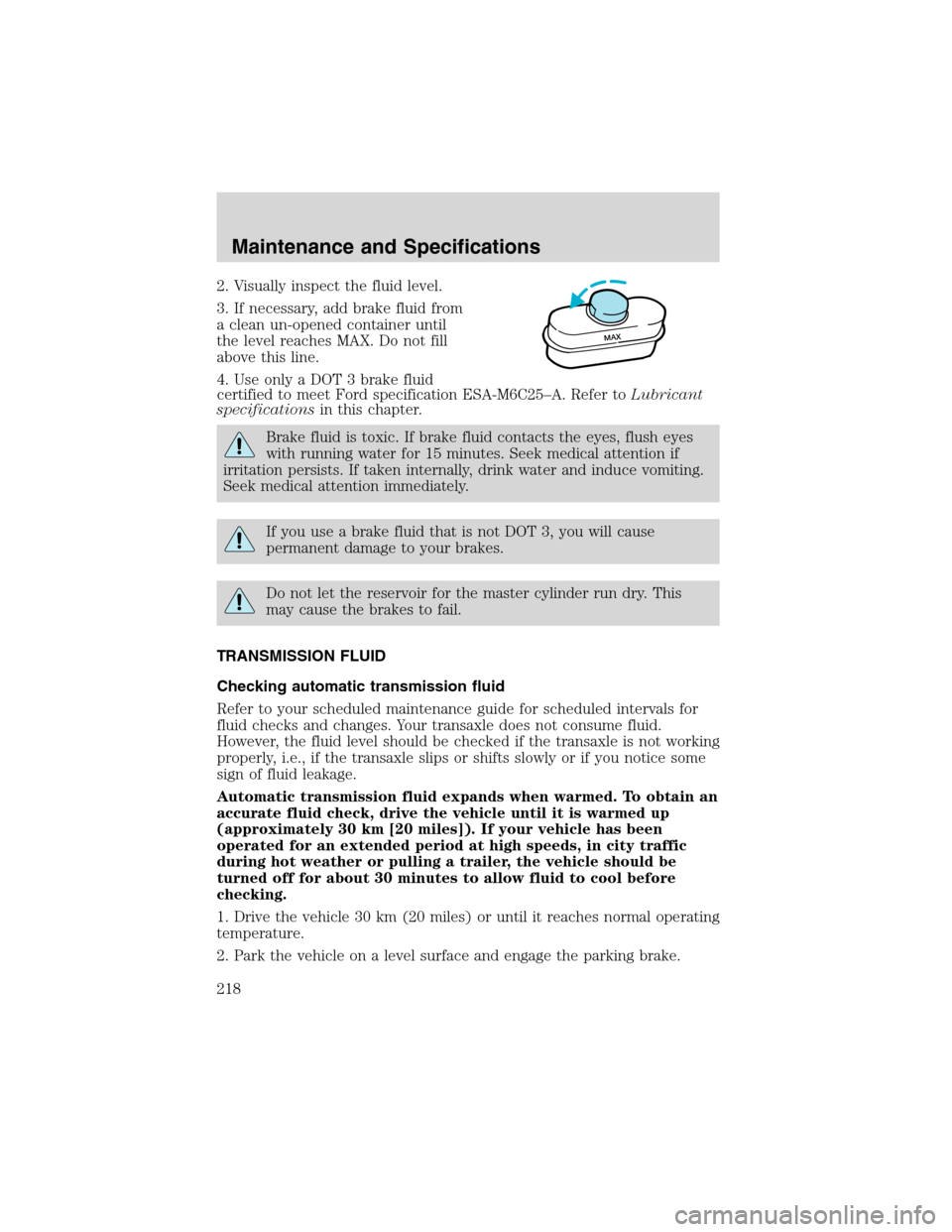
2. Visually inspect the fluid level.
3. If necessary, add brake fluid from
a clean un-opened container until
the level reaches MAX. Do not fill
above this line.
4. Use only a DOT 3 brake fluid
certified to meet Ford specification ESA-M6C25–A. Refer toLubricant
specificationsin this chapter.
Brake fluid is toxic. If brake fluid contacts the eyes, flush eyes
with running water for 15 minutes. Seek medical attention if
irritation persists. If taken internally, drink water and induce vomiting.
Seek medical attention immediately.
If you use a brake fluid that is not DOT 3, you will cause
permanent damage to your brakes.
Do not let the reservoir for the master cylinder run dry. This
may cause the brakes to fail.
TRANSMISSION FLUID
Checking automatic transmission fluid
Refer to your scheduled maintenance guide for scheduled intervals for
fluid checks and changes. Your transaxle does not consume fluid.
However, the fluid level should be checked if the transaxle is not working
properly, i.e., if the transaxle slips or shifts slowly or if you notice some
sign of fluid leakage.
Automatic transmission fluid expands when warmed. To obtain an
accurate fluid check, drive the vehicle until it is warmed up
(approximately 30 km [20 miles]). If your vehicle has been
operated for an extended period at high speeds, in city traffic
during hot weather or pulling a trailer, the vehicle should be
turned off for about 30 minutes to allow fluid to cool before
checking.
1. Drive the vehicle 30 km (20 miles) or until it reaches normal operating
temperature.
2. Park the vehicle on a level surface and engage the parking brake.
MAX
Maintenance and Specifications
218
Page 235 of 240
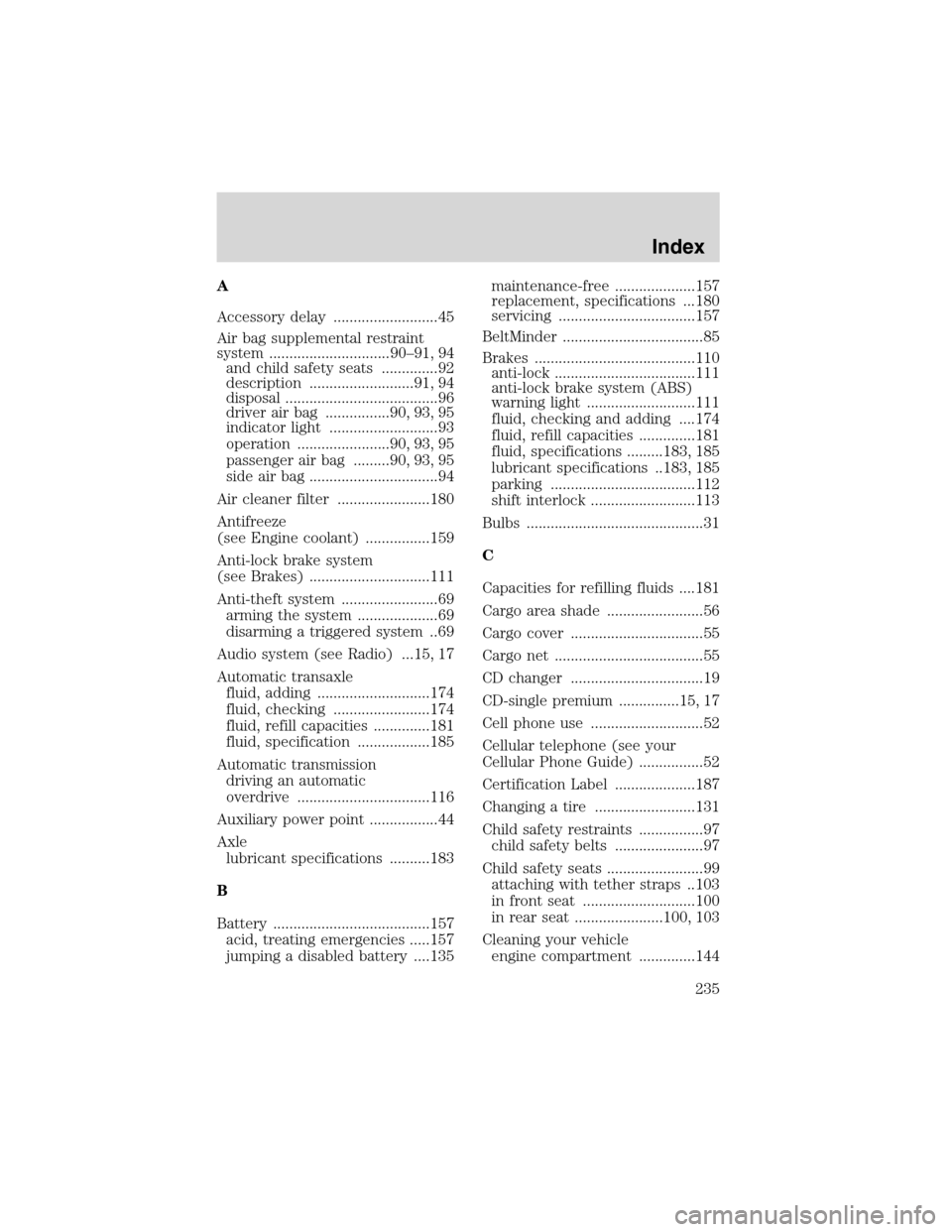
A
Accessory delay ..........................45
Air bag supplemental restraint
system ..............................90–91, 94
and child safety seats ..............92
description ..........................91, 94
disposal ......................................96
driver air bag ................90, 93, 95
indicator light ...........................93
operation .......................90, 93, 95
passenger air bag .........90, 93, 95
side air bag ................................94
Air cleaner filter .......................180
Antifreeze
(see Engine coolant) ................159
Anti-lock brake system
(see Brakes) ..............................111
Anti-theft system ........................69
arming the system ....................69
disarming a triggered system ..69
Audio system (see Radio) ...15, 17
Automatic transaxle
fluid, adding ............................174
fluid, checking ........................174
fluid, refill capacities ..............181
fluid, specification ..................185
Automatic transmission
driving an automatic
overdrive .................................116
Auxiliary power point .................44
Axle
lubricant specifications ..........183
B
Battery .......................................157
acid, treating emergencies .....157
jumping a disabled battery ....135maintenance-free ....................157
replacement, specifications ...180
servicing ..................................157
BeltMinder ...................................85
Brakes ........................................110
anti-lock ...................................111
anti-lock brake system (ABS)
warning light ...........................111
fluid, checking and adding ....174
fluid, refill capacities ..............181
fluid, specifications .........183, 185
lubricant specifications ..183, 185
parking ....................................112
shift interlock ..........................113
Bulbs ............................................31
C
Capacities for refilling fluids ....181
Cargo area shade ........................56
Cargo cover .................................55
Cargo net .....................................55
CD changer .................................19
CD-single premium ...............15, 17
Cell phone use ............................52
Cellular telephone (see your
Cellular Phone Guide) ................52
Certification Label ....................187
Changing a tire .........................131
Child safety restraints ................97
child safety belts ......................97
Child safety seats ........................99
attaching with tether straps ..103
in front seat ............................100
in rear seat ......................100, 103
Cleaning your vehicle
engine compartment ..............144
Index
235
Page 238 of 240
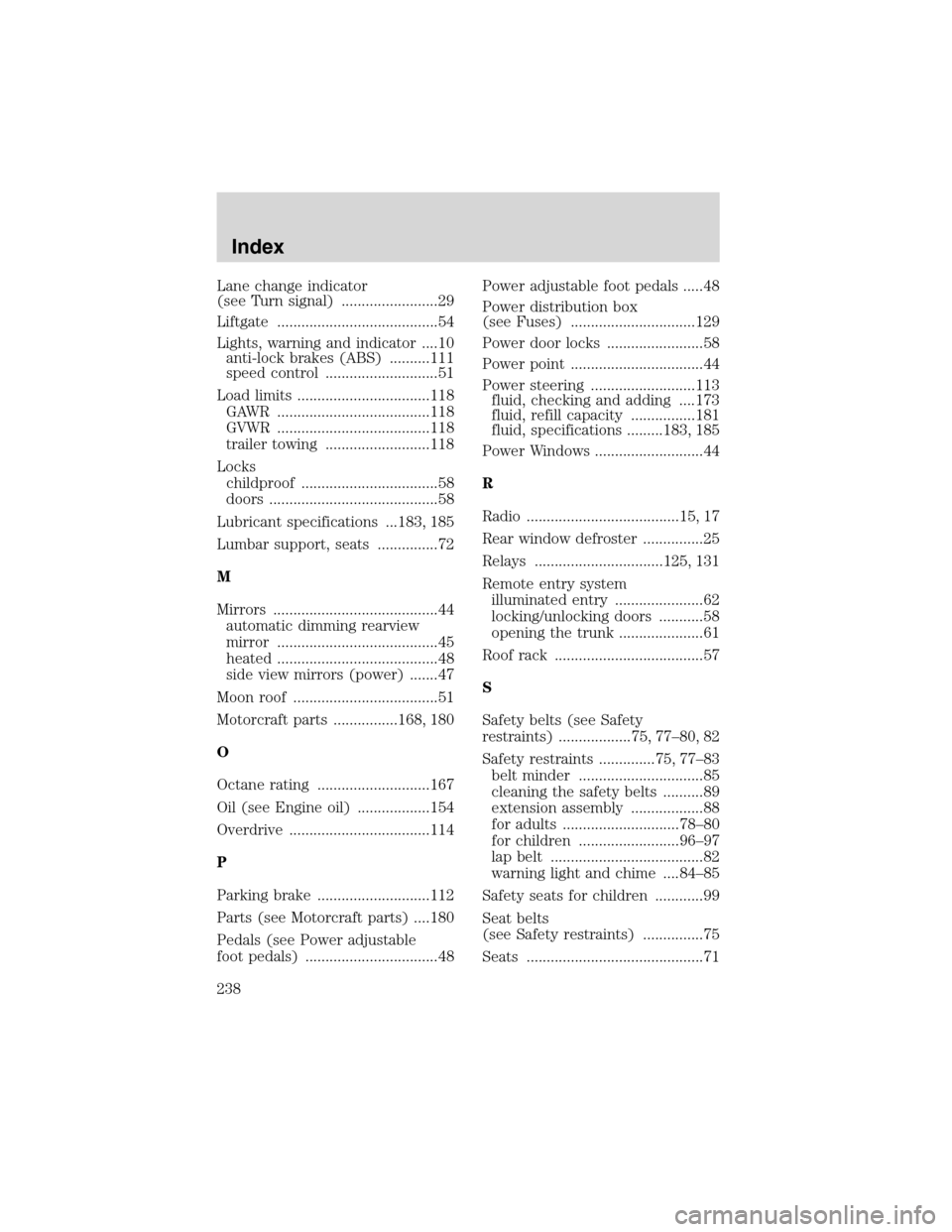
Lane change indicator
(see Turn signal) ........................29
Liftgate ........................................54
Lights, warning and indicator ....10
anti-lock brakes (ABS) ..........111
speed control ............................51
Load limits .................................118
GAWR ......................................118
GVWR ......................................118
trailer towing ..........................118
Locks
childproof ..................................58
doors ..........................................58
Lubricant specifications ...183, 185
Lumbar support, seats ...............72
M
Mirrors .........................................44
automatic dimming rearview
mirror ........................................45
heated ........................................48
side view mirrors (power) .......47
Moon roof ....................................51
Motorcraft parts ................168, 180
O
Octane rating ............................167
Oil (see Engine oil) ..................154
Overdrive ...................................114
P
Parking brake ............................112
Parts (see Motorcraft parts) ....180
Pedals (see Power adjustable
foot pedals) .................................48Power adjustable foot pedals .....48
Power distribution box
(see Fuses) ...............................129
Power door locks ........................58
Power point .................................44
Power steering ..........................113
fluid, checking and adding ....173
fluid, refill capacity ................181
fluid, specifications .........183, 185
Power Windows ...........................44
R
Radio ......................................15, 17
Rear window defroster ...............25
Relays ................................125, 131
Remote entry system
illuminated entry ......................62
locking/unlocking doors ...........58
opening the trunk .....................61
Roof rack .....................................57
S
Safety belts (see Safety
restraints) ..................75, 77–80, 82
Safety restraints ..............75, 77–83
belt minder ...............................85
cleaning the safety belts ..........89
extension assembly ..................88
for adults .............................78–80
for children .........................96–97
lap belt ......................................82
warning light and chime ....84–85
Safety seats for children ............99
Seat belts
(see Safety restraints) ...............75
Seats ............................................71
Index
238